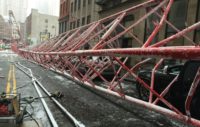The MTA's Lisberg said the MTA does not conduct its own inspections other than making sure the contractors have "appropriate inspection paperwork" from the DOB. "We don't inspect cranes," he said. "That's what the contractors and DOB do. We don't inspect hoisting mechanisms ourselves."
DOB spokesman Tony Sclafani said the department is focusing its investigation on the operating and maintenance history of the crane, "which was required to be examined by the contractor on a daily and monthly basis to ensure it was safe to operate. Each crane registered with the city is required to undergo a full inspection on an annual basis, and that was clearly done in this case," Sclafani said. "This is an MTA-controlled site, and as with any MTA project in the city, the DOB does not have full oversight."
In a statement, Yonkers Contracting said, "We are cooperating fully with all authorities looking into this incident and will do all that we can to help officials determine the cause. Safety is our top priority and we are committed to following all required standards."
Though investigators have released little information on the accident's cause—aside from announcing their focus on the hoisting system—crane experts suspect a primary cause was a number of broken wires that comprise the boom hoist's wire-rope cables. Despite the fact that the crane's hook was empty at the time of the accident, a significant number of frayed cables could still cause the boom to snap.
"The boom hoist cable perhaps had too many broken cables to safely sustain the weight of even an empty boom," said one crane expert with knowledge of the project. He asked not to be named as he was not authorized to speak publicly about the accident. "Just because a crane is carrying no load doesn't mean the boom hoist cable is not seeing significant stress."
Another possibility is that the cable "jumped a sheave," which sometimes occurs when the cables are slackened while releasing a load and one or more slips out of its sheave and get snagged. "That's another potential cause," said the expert. "If a cable runs between the sheaves for an extended period of time, a sawing action occurs, which can severely weaken the rope and ultimately cause it to part."
The crane was manufactured in 1988 by Manitowoc, according to Yonkers Contracting. The owner says it was certified as rebuilt in 2011.


